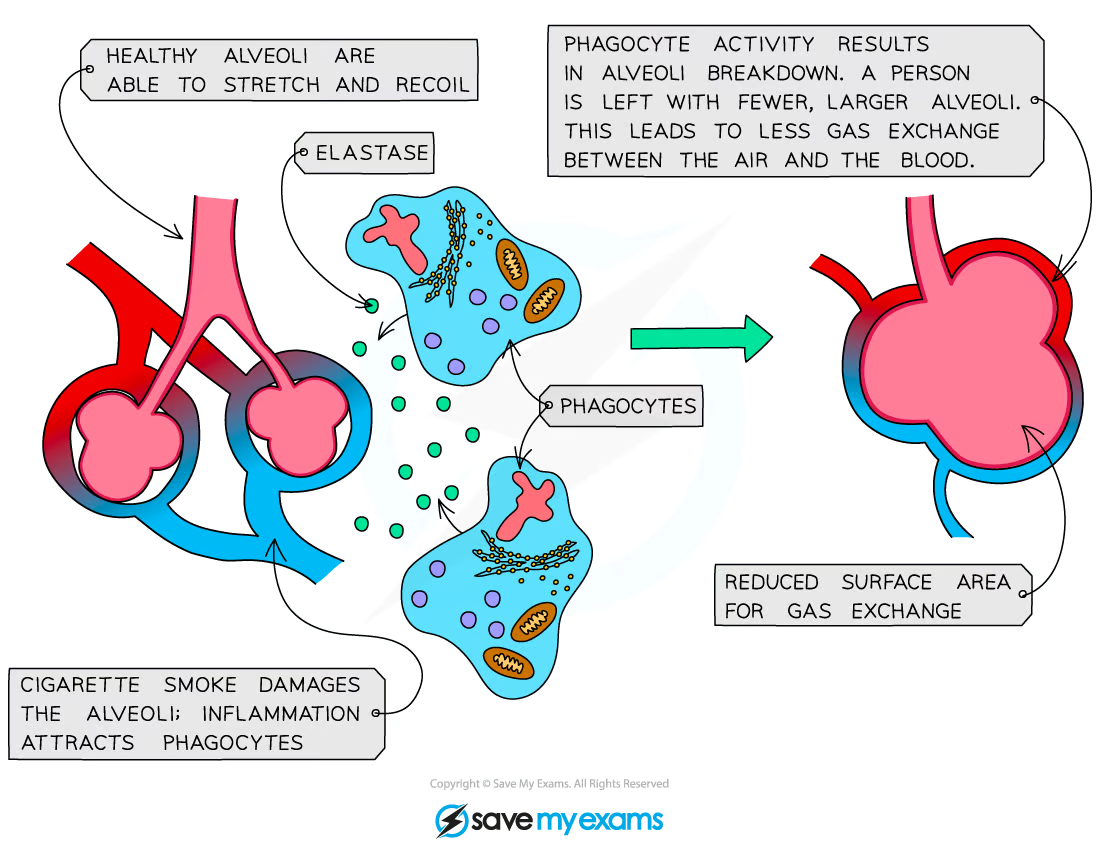2c. Structure & Function in Living Organisms: Respiration, Gas Exchange
1/33
There's no tags or description
Looks like no tags are added yet.
Name | Mastery | Learn | Test | Matching | Spaced |
|---|
No study sessions yet.
34 Terms
what is ATP?
during the process of cellular respiration, glucose is broken down and several molecules of ATP are produced
ATP can be broken down to release energy for living processes

define aerobic respiration
the chemical reaction in cells that uses oxygen to break down nutrient molecules to release energy
it involves the complete breakdown of glucose to release a relatively large amount of energy
carbon dioxide and water are produced as waste products, as well as releasing useful cellular energy

define anaerobic respiration
the chemical reaction in cells that breaks down nutrient molecules to release energy without using oxygen
it involves the incomplete breakdown of glucose and so releases a relatively small amount of energy
different breakdown products are formed depending on the type of organism that the anaerobic respiration is taking place in
how/why does anaerobic respiration take place in animals?
takes place in muscle cells during vigorous exercise
when we exercise, muscles have a higher demand for energy
our bodies can only deliver so much oxygen to our muscle cells for aerobic respiration
when oxygen runs out, glucose is broken down without it, producing lactic acid instead
glucose has not been fully broken down, meaning there is still energy stored within the bonds of lactic acid
lactic acid builds up in muscle cells and lowers the pH of tissues
acidic conditions can denature the enzymes in cells
it will eventually be broken down using oxygen to produce carbon dioxide and water as waste products

how does anaerobic respiration take palce in plants and fungi?
plants and yeast break down glucose without oxygen to produce ethanol and carbon dioxide
anaerobic respiration in yeast cells is called fermentation
fermentation is important in the manufacture of bread and brewing
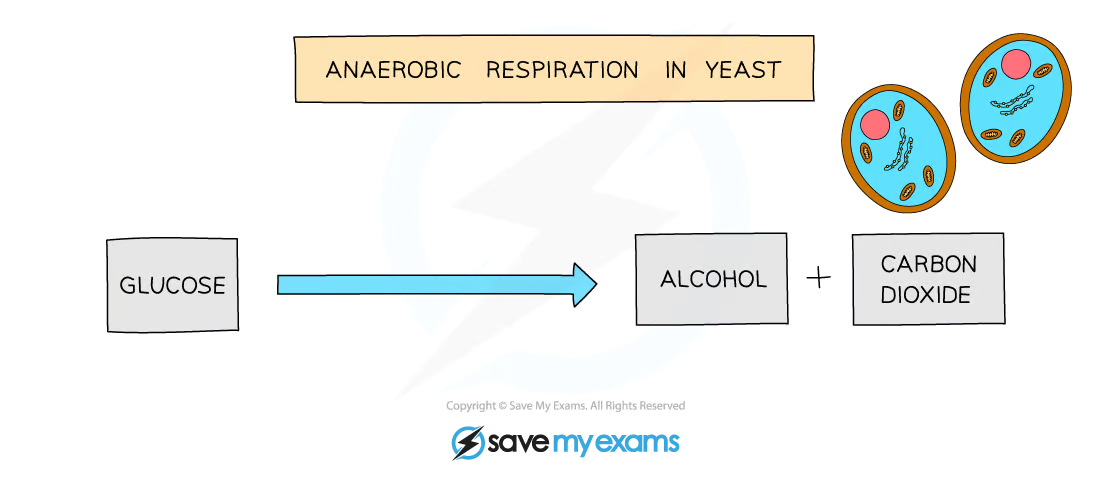
how are aerobic and anaerobic respiration different?
in terms of oxygen, glucose breakdown, products, and energy released
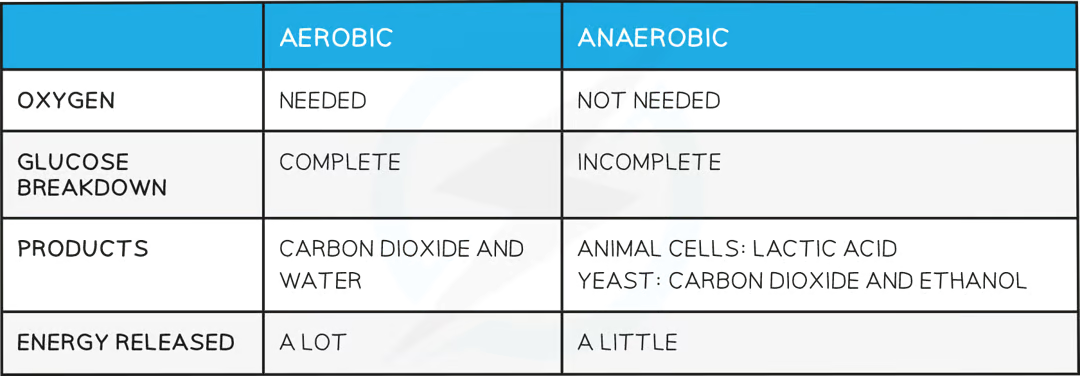
PRACTICAL: Demonstrating the production of carbon dioxide
METHOD
measure out 10cm³ of hydrogencarbonate indicator into 3 boiling tubes
put in a layer of cotton wool
place 10 germinating seeds in tube A
place 10 boiled/dead seeds in tube B
place 10 glass beads in tube C
seal each gube with a rubber bung
after 3 hours, observe the colour of the indicator
HYDROGENCARBONATE INDICATOR
red in atmospheric CO2 levels
yellow in high CO2 levels as it dissolves in water and forms carbonic acid
purple in low CO2 levels as the solution turns more alkaline
RESULTS
Tube A should turn yellow as the seeds are respiring and producing CO2
Tube B should remain red as the dead seeds produce no CO2
Tube C should remain red as there is no living material in them
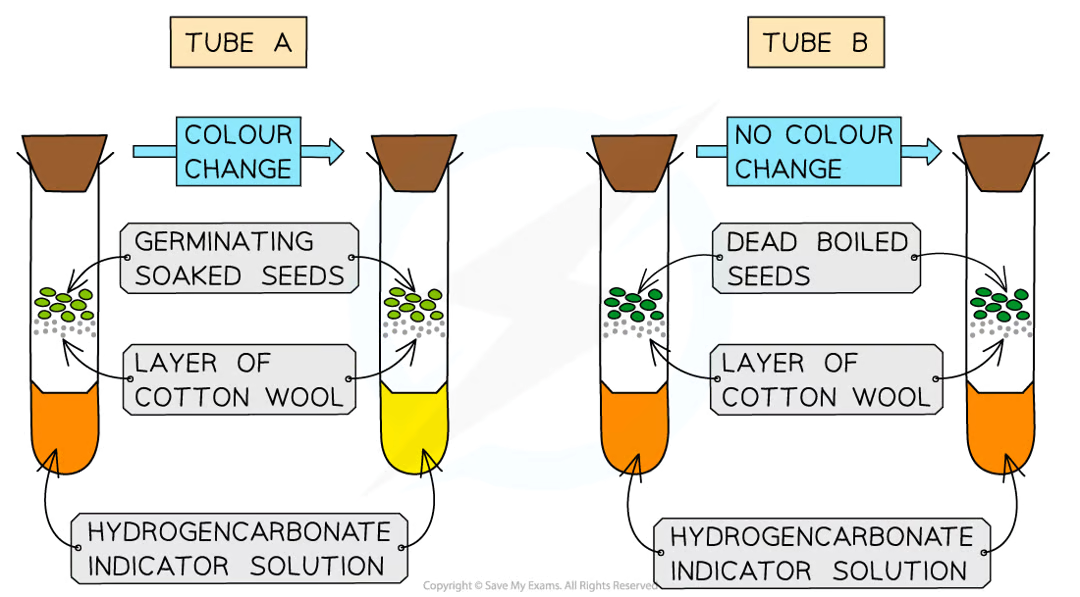
PRACTICAL: Demonstrating the production of heat
METHOD
set up the flasks as shown in the diagram
Flask A with dead seeds
Flask B with germinating seeds
make sure the cotton wool is plugging the top of each flask
hold the thermometer in place with the cotton wool
invert the flask
record the initial temperature
after 4 days, record the final temperature
RESULTS
the thermometer in Flask B should show an increase in temperature
Flask A should remain at room temperature
this is because the seeds in Flask B are respiring and producing thermal energy in the process
this shows that respiration is an exothermic reaction
the seeds in Flask A are not respiring because they are dead, so the temperature remains the same
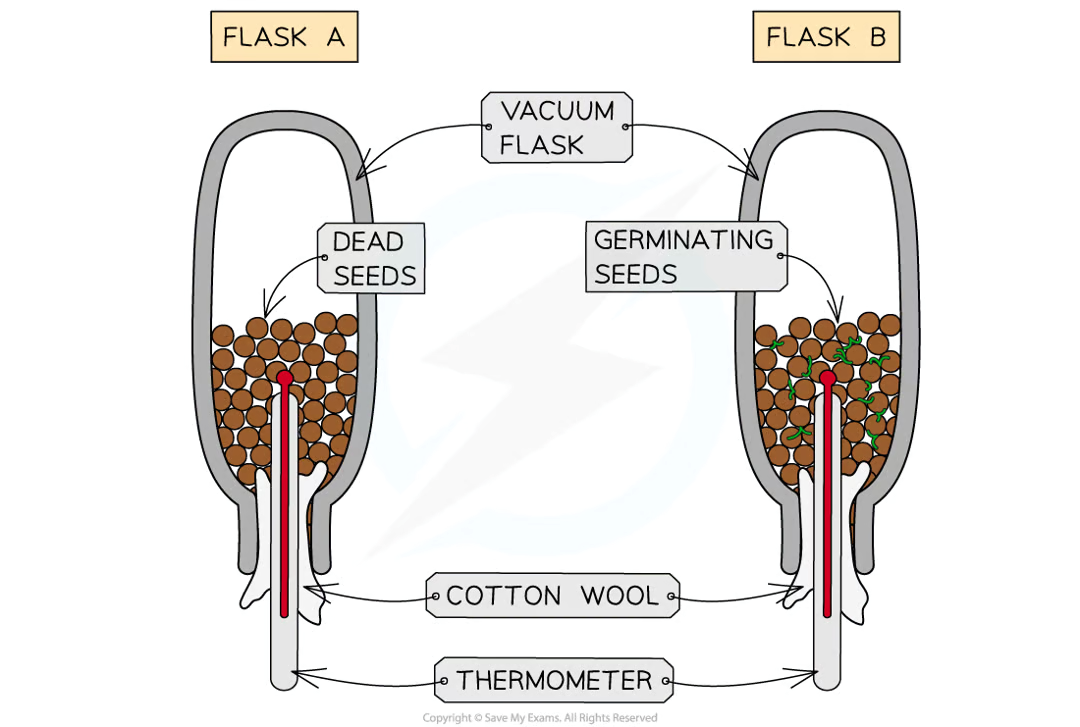
how does diffusion occur in single-celled vs multicelled organisms?
single-celled: through the cell membrane, as there is a very short diffusion distance
multicellular: through exchange surfaces and organ systems
how does gas exchange occur in respiration?
oxygen diffuses down the concentration gradient from outside the leaf to inside the leaf
cells use oxygen in respiration, so the O2 concentration inside leaves is always low
carbon dioxide diffuses down the concentration gradient from inside the leaf to outside the leaf
what adaptations do leaves have to maximise gas exchange?
externally + internally
thin: gives a short diffusion distance
flat: provides a large surface area to volume ratio
have many stomata: allow movement of gases in and out of the air spaces by diffusion
adaptations of the internal leaf structure/tissues include:
Air spaces to allow gas movement around the loosely packed spongy mesophyll cells
Many stomata in the lower epidermis open in sunlight to allow gas movement in and out of the leaf
Thin cell walls allow gases to move into the cells easily
Moist air which gases can dissolve into for easier movement into and out of cells
The close contact between the cells and the air spaces allows efficient gas exchange for photosynthesis and respiration
what are stomata and guard cells and how do they work?
stomata are spaces found between two guard cells predominantly on the lower epidermis of the leaf
guard cells are responsible for the opening and closing of the stomatal pore which controls gas exchange and water loss
Stomata open when water moves (by osmosis) into the guard cells causing them to become turgid
This allows gases to diffuse in and out of the leaf through the stomatal pore
Stomata tend to open when there is plenty of water and sunlight
Stomata close when the guard cells lose water (by osmosis) to the neighbouring epidermal cells and they become flaccid
This prevents any diffusion into or out of the leaf
Stomata tend to close due to low water availability or low sunlight
how does gas exchange in plants differ at night and day?
in the daytime, plants both respire and photosynthesise
the rate of photosynthesis tends to be higher than the rate of respiration
therefore there is a net diffusion of co2 into the plant and a net diffusion of oxygen out of the plant
during the nighttime, plants only respire
there is a net movement of oxygen into the plant and a net diffusion of carbon dioxide out of the plant during the nighttime
why does gas exchange in plants differ at night and day?
plants can only photosynthesise when they have access to light, but cells respire all the time
how does gas exchange occur in plants at low light intensitites?
the rate of photosynthesis is equal to the rate of respiration
this means that there is no net movement of oxygen or carbon dioxide in either direction
what are the structures of the respiratory system?
the thorax is the human chest cavity, and it consists of:
the lungs
the ribs
intercostal muscles
diaphragm
trachea
bronchi
bronchioles
alveoli
pleural membranes
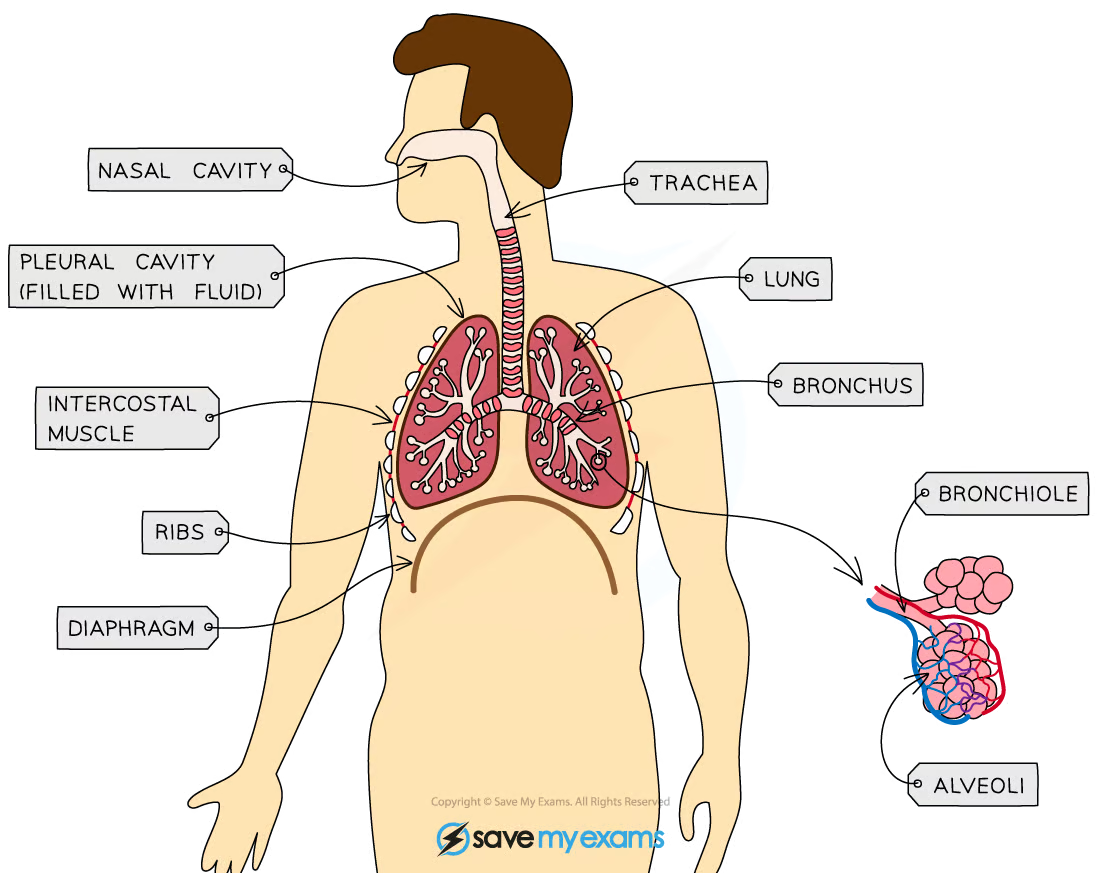
what adaptations do the lungs have to maximise gas exchange?
large surface area to allow for faster diffusion of gases
thin walls to ensure short diffusion distances
good ventilation with air to maintain a steep concentration gradient
good blood supply to maintain a steep concentration gradient
what is the function of the ribs?
bone structure that protects internal organs such as the lungs
what is the function of the intercostal muscles?
muscles between the ribs which control their movement, causing inhalation and exhalation
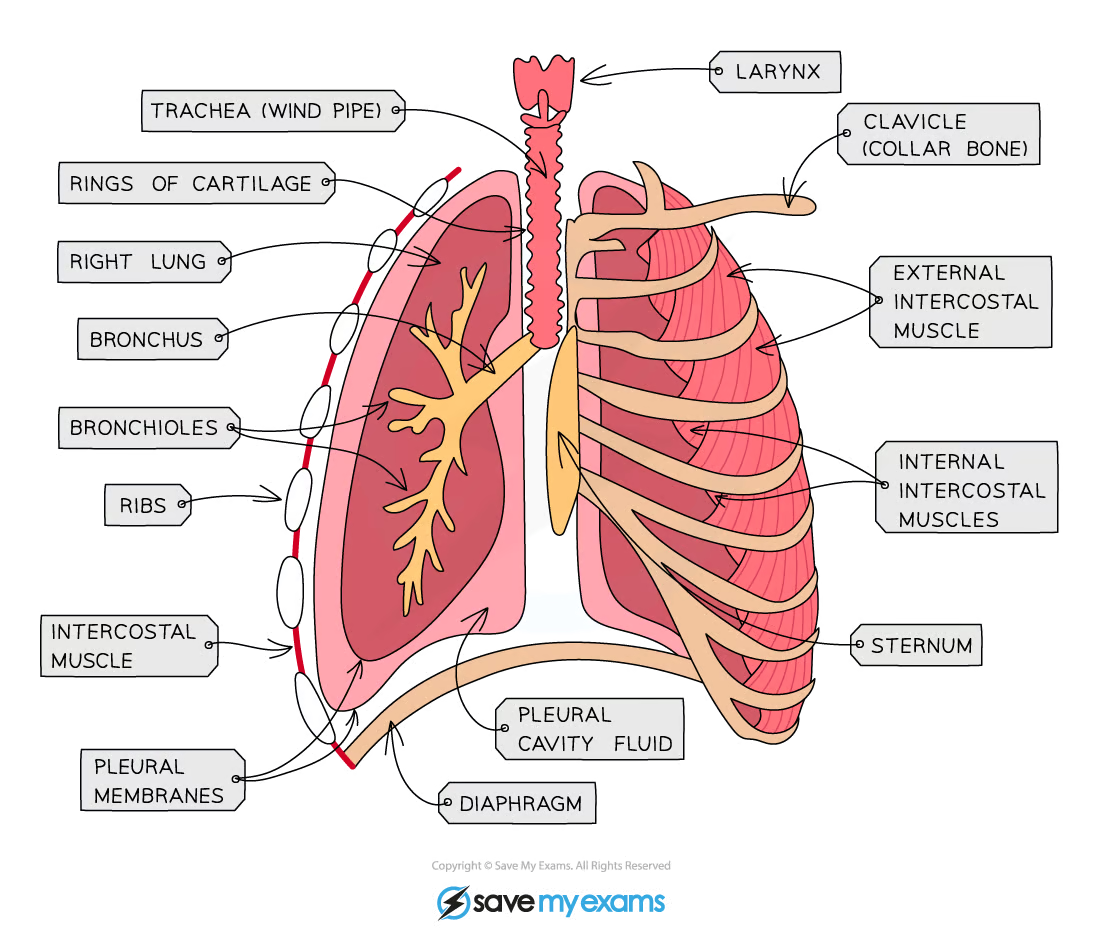
what is the function of the diaphragm?
sheet of connective tissue and muscle at the bottom of the thorax that helps change the volume of the thorax to allow inahlation and exhalation
separates the chest cavity from the abdomen
what is the function of the trachea?
windpipe that connects the mouth and nose to the lungs
what is the function of the larynx?
also known as the voice box, when air passes across here we are able to make sounds
what is the function of the bronchi?
large tubes branching off the trachea with one bronchus for each lung
what is the function of the bronchioles?
bronchi split to form smaller tubes called bronchioles in the lungs connected to alveoli
what is the function of the alveoli?
tiny air sacs where gas exchange takes place
what is the function of the pleural cavity?
the fluid filled space between the pleural membranes which reduces friction and allows the lungs to move freely
how do the intercostal muscles move?
the two sets of intercostal muscles work antagonistically
external intercostal muscles contract to pull the rib cage up during inhalation
internal intercostal muscles contract to pull the ribcage down during forced exhalation
what happens during inhalation?
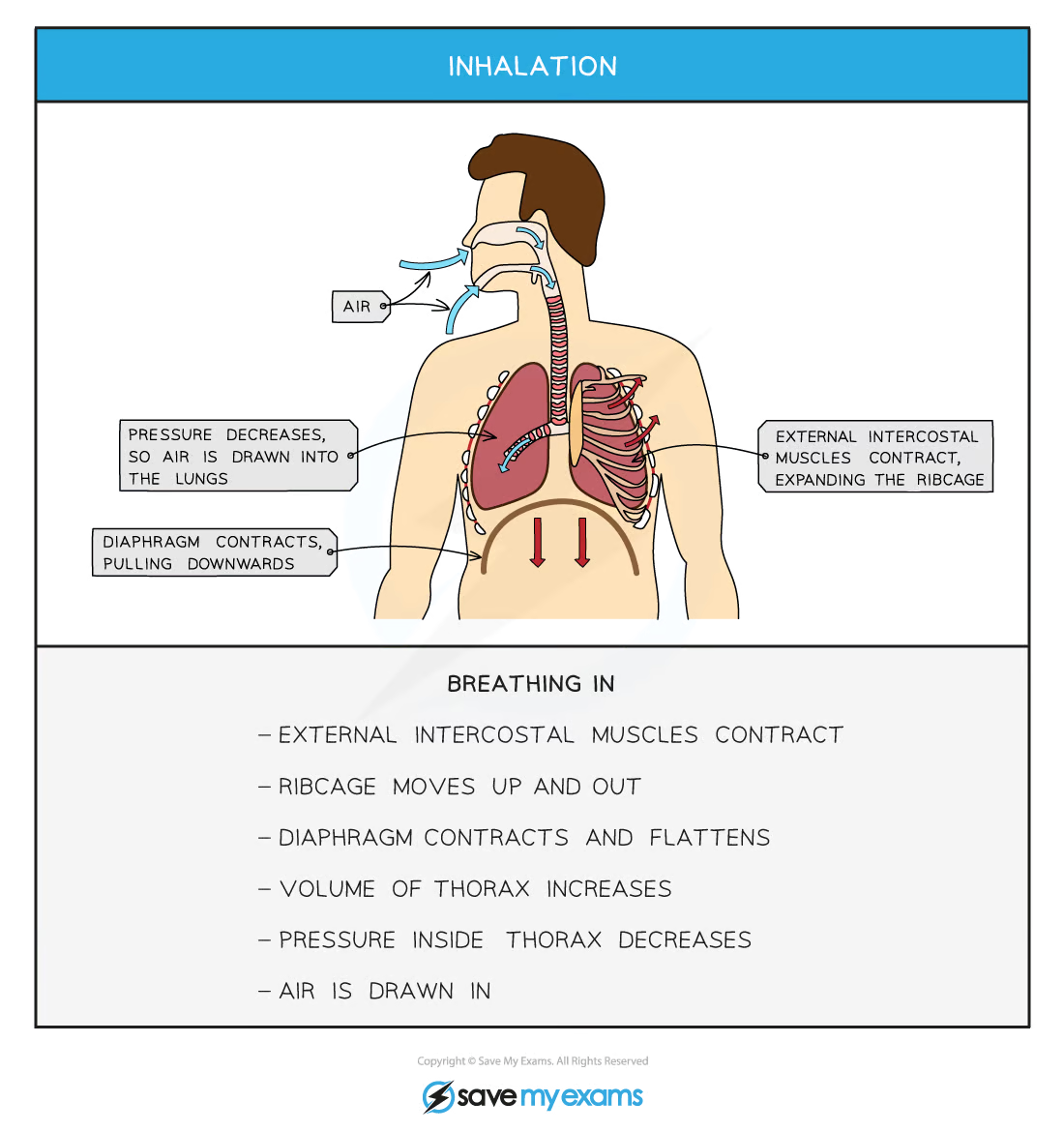
what happens during normal exhalation?
external intercostal muscles relax
ribcae moves down and in
diaphragm relaxe
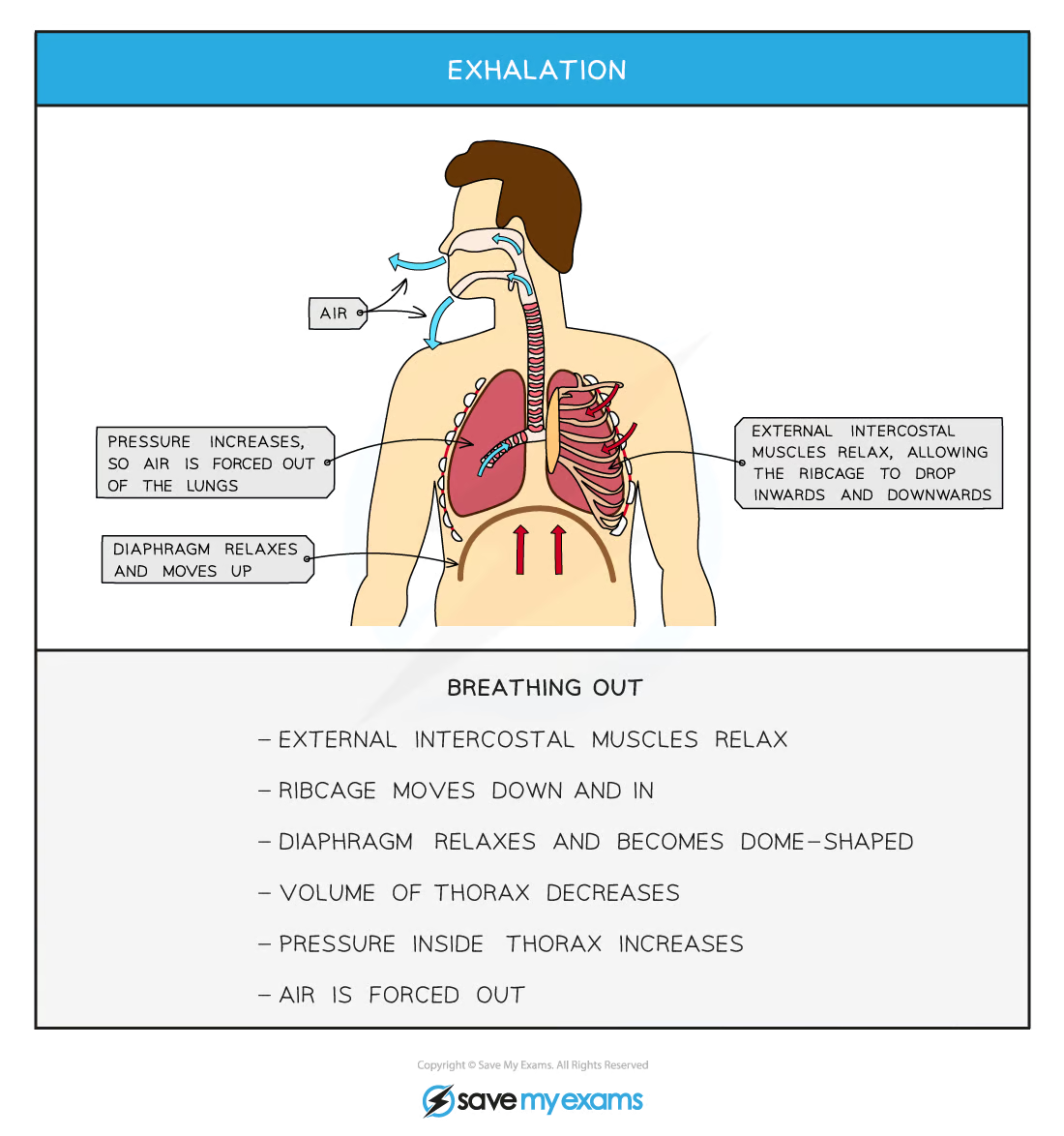
what happens during forced exhalation?
how are the alveoli adapted and specialised for gas exchange?
there are many rounded alveolar sacs which give a large SA:V ratio
alveoli (and the capillaries around them) have thin, single layers of cells to minimise diffusion distance
ventilation maintains high levels of oxygen and low levels of carbon dioxide in the alveolar air space, leading to a steep concentration gradient
good blood supply ensures a constant supply of blood high in carbon dioxide and low in oxygen to maintain concentration gradients
a layer of moisture on the surface of the alveoli helps diffusion as gases dissolve

what harmful chemicals are in cigarettes and what do they do?
nicotine
narrows blood vessels and increases heart rate, leading to increased blood pressure
leads to blood clots forming in arteries, resulting in heart attacks or strokes
carbon monoxide
binds irreversibly to haemoglobin, reducing the capacity of blood to carry oxygen
puts strain on the breathing system, as breathing freqency and depth need to increase to supply the same amount of oxygen
the circulatory system needs to pump blood faster, raising blood pressure and increasing the risk of coronary heart disease or stroke
tar
is a carcinogen linked to increased chances of cancerous cells developing in the lungs
contributes to COPD, which occurs when chronic bronchitis and emphysema occur together
what is chronic bronchitis?
tar stimulates goblet cells and mucus glands to enlarge and produce more mucus
mucus builds up, blocking the smallest bronchioles and leading to infections
the build-up of mucus can result in damage to the cilia, preventing them from beating and removing the mucus
a smoker’s cough is the attempt to move the mucus
what is emphysema?
emphysema is a result of frequent infection
infections occur more frequently in smokers due to the build-up of mucus that occurs in the lungs
phagocytes that enter the lungs release elastase, an enzyme that breaks down the elastic fibres in the alveoli
the alveoli become less elastic and cannot stretch, so many burst
the breakdown of alveoli reduces the surface area for gas exchange
emphysema patients become breathless and wheezy, and may need a constant supply of oxygen to stay alive
